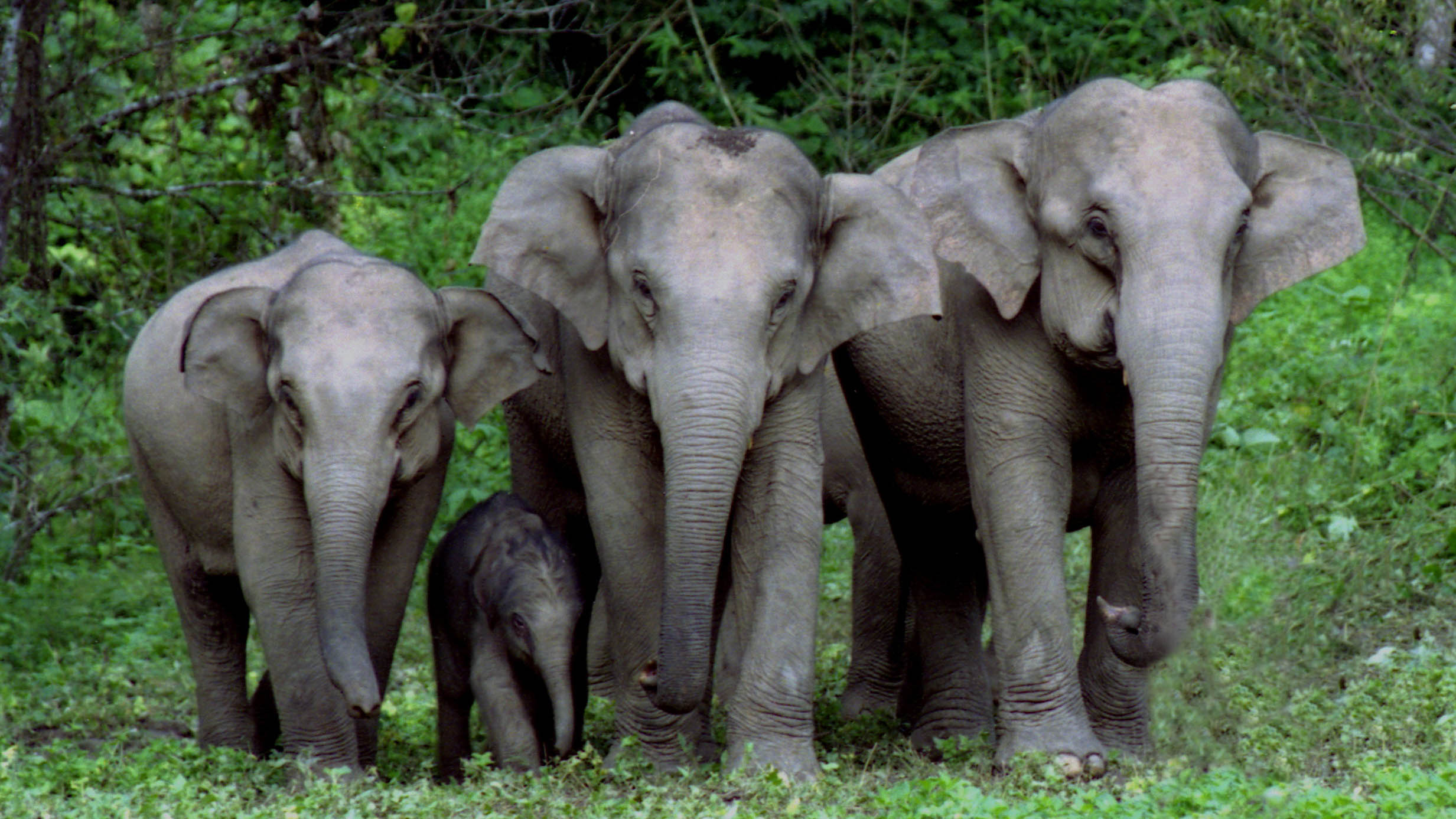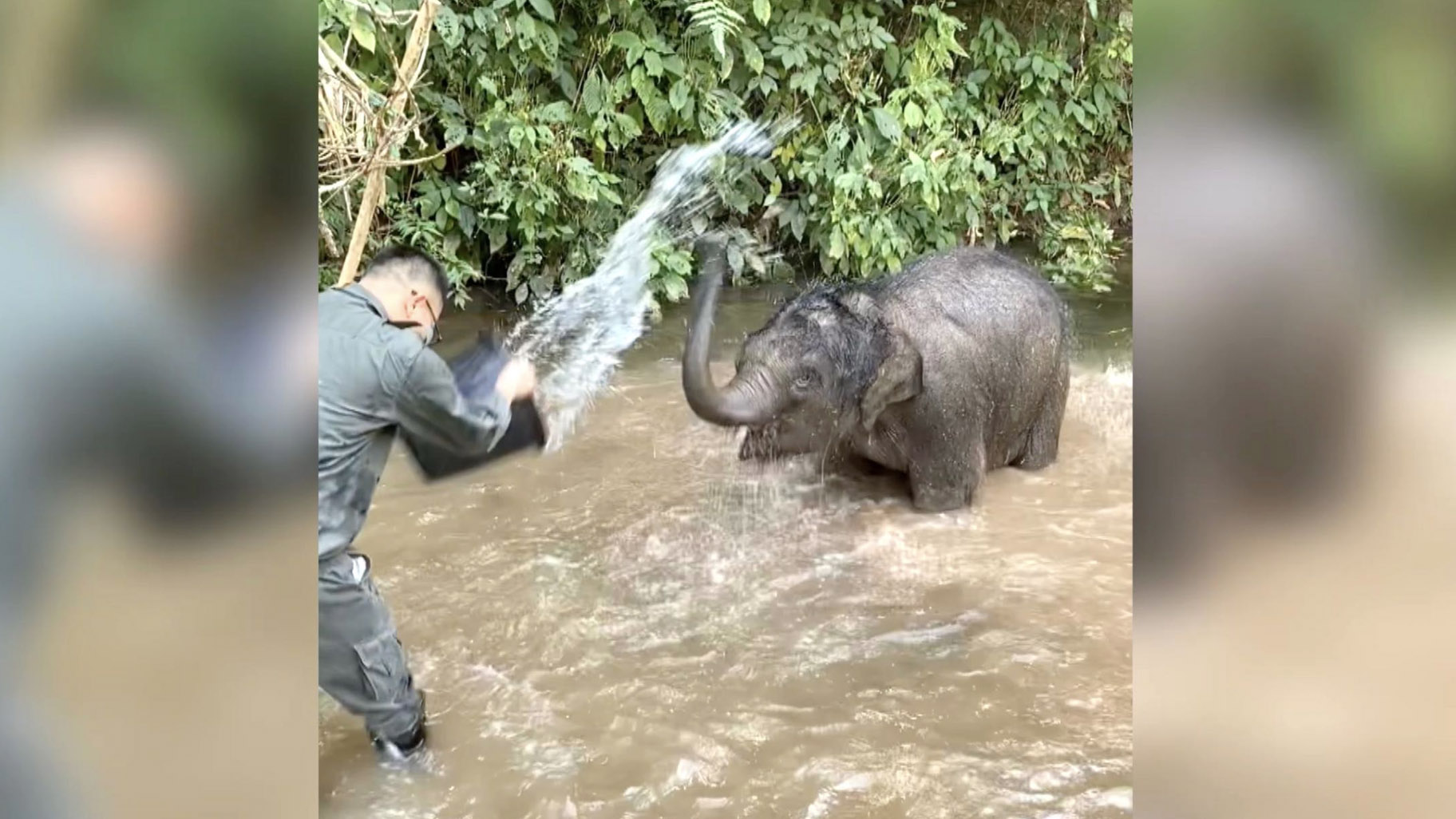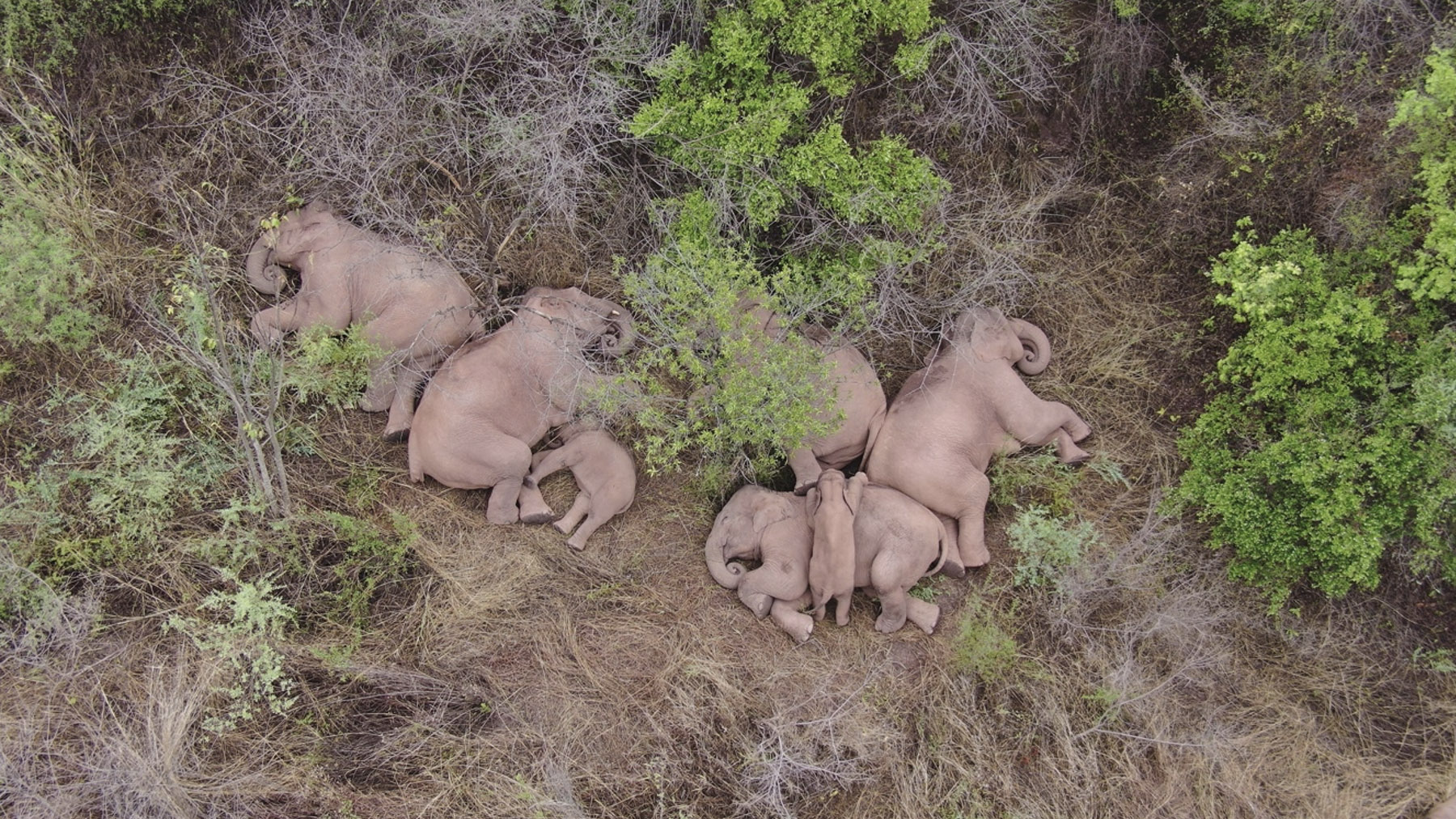02:53

Editor's note: China has made enormous efforts in ecological protection over the past decade, in particular, wildlife conservation. As a result, the population of some endangered species has steadily grown. In CGTN's special coverage Dynamics of China, reporter Yang Jinghao looks at the measures taken to protect Asian elephants in the country.
Long Long, a baby Asian elephant, attracted much attention on the Internet weeks ago with a video showing him sliding down a muddy slope.
In the clip, following his first attempt, the creature went uphill and glided down again with his knees bent on the ground.
Months ago, another video showing him playing water with his keeper, also impressed many Web users.

Long Long and his keeper splash water to each other./Li Zheng
Long Long and his keeper splash water to each other./Li Zheng
But his mood was nothing like this when he was rescued in July last year. At that time, the elephant was in a serious physical condition.
"One of his feet was trapped in vine plants, resulting in a circular wound. I was shocked when I first saw him. There was a lot of pus, and the foot was seriously festering," said Xiong Chaoyong, a keeper at the Asian Elephant Breeding and Rescue Center.
The center is the only facility of its kind in China. It's located in southwest China's Xishuangbanna, a region mainly inhabited by Dai ethnic group and home to the largest number of Asian elephants in the country.
Xiong said after months of meticulous treatment, Long Long gradually recovered and got increasingly lively and naughty.

Prince William interacts with Ran Ran under the company of Xiong Chaoyong (R)./Xiong Chaoyong
Prince William interacts with Ran Ran under the company of Xiong Chaoyong (R)./Xiong Chaoyong
Caring for elephants like their own children
This is only one of the many success stories at the rescue center. Since its creation in 2008, it has saved more than 20 elephants in need of help, who were mostly wounded and separated with their family.
Xiong Chaoyong is a veteran caretaker at the center. His first rescue mission happened in 2005 before the facility was formally established. That time, a female elephant was found at stake in the wild.
"At first, I thought her chances of survival were slim. Judging from her overall condition, some experts had the idea of giving up on her and even proposed euthanasia," Xiong told CGTN. "But I think it's our obligation to try our best to rescue her."
With Xiong's care, Ran Ran gradually got on her feet. He said they formed a close bond during this time and he considered the elephant as his own "daughter".
In 2015, when Prince William, Duke of Cambridge visited Xishuangbanna as a leg of his China tour, he also interacted with Ran Ran and fed her carrots.
A surprise came in 2019 when the mammal gave birth to a daughter. Xiong joked that the new arrival made him a "grandfather".
Today, more than 10 caretakers work in the center. Their daily routine includes bathing and feeding the giants, and taking them to the wild for field survival training.
"I will work to train more new caretakers, helping them know more about elephant rescue, treatment and daily care," said Xiong. "I hope more people will join the undertaking of Asian elephant conservation."

A herd of Asian elephants forage in a border town in Xishuangbanna./Jin Xin
A herd of Asian elephants forage in a border town in Xishuangbanna./Jin Xin
Promoting human-elephant harmony
The efforts by the "elephant dads" are just one example of how China has endeavored to protect the rare species.
In China, Asian elephants are put under the top-level protection, and any action that harms the giants is deemed illegal.
Data from China's forestry authority shows that over the past decade, the population of elephants in the country has increased by about 100. Now more than 300 elephants live in the cities of Xishuangbanna, Pu'er and Lincang of Yunnan Province.
But the growth has also created new challenges as the jumbo mammals have visited human habitats more frequently for food.
Installing metal guardrails around people's residences near elephant habitats to prevent unexpected visits by the giant neighbors has been a common practice during the past few years.
"In the past, as the elephants frequently came to our village, we just lived in horror. Since local authorities experimented with the railing project here in 2017, they've rarely bothered us, and we're feeling a lot more relieved now," Feng Guanglin, a villager living in the proximity of a nature reserve, told CGTN during an interview in 2021.
Today, smart surveillance and warning systems have also been set up to avoid human-elephant conflict, which have been proved effective.
In the areas that the tuskers often visit, so-called "elephant canteens" have also been built by growing the crops they love, such as corns and plantains. In the city of Pu'er, some 7,000 mu, or about 467 hectares of these foods were added this year.
As an innovative approach, Yunnan started to pilot an insurance program in 2010, through which people will get compensation when they or their crops were harmed by wild animals. So far, some 173 million yuan ($24 million) has been compensated in elephant-related cases.

The migrating elephants asleep during their northward journey./Shen Qingzhong
The migrating elephants asleep during their northward journey./Shen Qingzhong
Building a better home for elephants
The story about the migrating elephant in Yunnan can be a good example to show the harmonious coexistence between human being and the tusked friends.
Last year, a herd of elephants left their natural habitat and trekked all the way north to the provincial capital Kunming. With joint efforts by authorities and the public, they finally returned safe and sound.
Now, authorities are working on a plan to build a designated national park for Asian elephants in Yunnan. Some experts said this initiative can provide the species with a larger and more integrated habitat, as the current ones are somewhat fragmented.
"We need to increase elephant habitat, particularly elephant habitat without much contact with people. In that sense, China is now planning a new national park. I think that's a very good thing. We need to expand the amount of protected areas, but also need to think about how to do all these management outside the protected areas,"Ahimsa Campos-Arceiz, a Spanish researcher at Xishuangbanna Tropical Botanical Garden of the Chinese Academy of Sciences, told CGTN.
In October 2021, China announced the establishment of the first batch of national parks, which aim to preserve important wildlife sanctuaries as well as precious species such as giant pandas and Siberian tigers.
"The Asian elephant national park sets a 'double-target protection' strategy, which means it not only aims to help the elephant population grow, but will also protect the tropical rainforests, which are valuable as well," said Chen Fei, director of the Asian Elephant Research Center under the National Forestry and Grassland Administration.
(Cover image is a herd of Asian elephants walk in the tropical rainforests in Xishuangbanna National Nature Reserve, provided by Qiu Kaipei)
(If you want to contribute and have specific expertise, please contact us at nature@cgtn.com.)